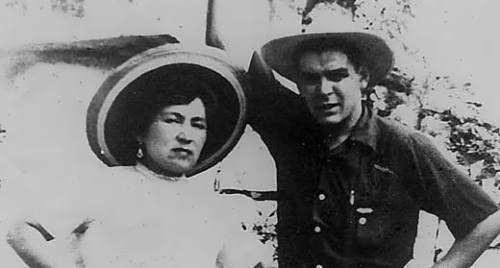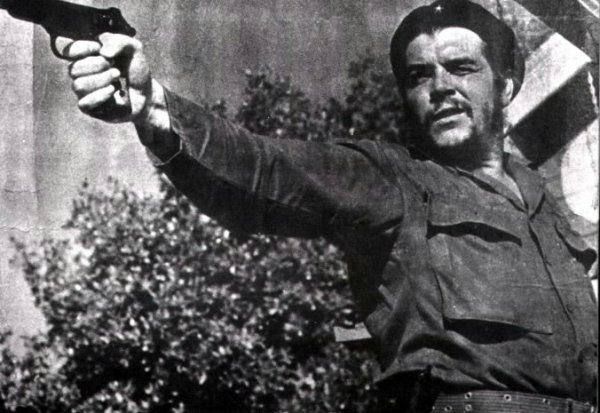
His famous image in the beret flashes now not only on pages of historical and political publications - this image has become widespread in pop culture.
It is worth dwelling in detail on this famous figure that fought for the communist ideals.
Ernesto Guevara de la Serna was born on June 14, 1928 in the Argentine city of Rosario. Guevara was not healthy – at the age of two he suffered a severe form of bronchial asthma, which tortured him throughout his life. Because of asthma, he could not attend school for a while, but since childhood he was curious and enjoyed studying at home.
In 1945, Guevara entered the medical faculty, inspired by the example of Albert Schweitzer, wishing to help leprous patients.
In 1951, Ernesto, along with his friend Alberto Granado who was also a doctor, went on a tour of South America on an old motorcycle, but it was constantly broken during their trips. Yet they traveled to Chile, Peru, Colombia and Venezuela.

In 1953, Ernesto Che Guevara graduated from the National University of Buenos Aires and received a doctor's degree. In the same year, he goes on a second journey for one year, during which he meets his future wife Hilda Gadea. Her revolutionary views greatly influenced Che Guevara. People begin to notice him among politically active citizens; they consider him a dangerous communist and refer to left-wing radicals. When rumors spread that the US invasion against the President of Guatemala Arbenz is due, Che Guevara goes there to support him by taking part in the defense of the government.
In 1954, he settled in Mexico City, where he tried to get a job as a journalist, but his article "I saw the overthrow of Arbenz" did not help him in this matter.
The prefix to the name of the revolutionary was received as a result of frequent use of interjection "che" in oral speech - he began to sign so as to emphasize his Argentine roots.
At the end of June, 1955, Guevara was informed of preparations for an armed expedition to Cuba. Soon there was an acquaintance with Raul Castro who had a good impression on Che: "He speaks better than others, in addition, he thinks." Fidel Castro at this time in the US collected money for the expedition.
At the first meeting, Fidel Castro was struck by the erudition of Ernesto Guevara and his well-formed political convictions. In the forthcoming expedition Che was to perform the duties of a doctor.
June 22, 1956, Fidel Castro was arrested in Mexico City. In a secret apartment, other of his comrades were captured, among whom was Che. The conspirators were caught thanks to a provocateur who managed to penetrate their ranks. The police also detained Hilda Gadea, but after a while they were released, and preparation for sailing to Cuba was in full swing - due to fear of being seized again. Before the expedition, Che managed to run in his home to say goodbye to his wife and daughter and write a farewell letter to his parents, and then immediately went to the port.

In 1957 Che Guevara became commander of one of the five largest partisan formations. In the same year he was conferred the rank of commandant. In November, 1958, Guevara and his column seized the strategically important object of the province - the city of Santa Clara, which is the center of Cuba. Fulgencio Batista was forced to flee the country, which came under the control of revolutionaries.

After the victory of the revolutionaries, Ernesto Guevara was appointed president of the National Bank of Cuba, and after the Minister of Industry of the Liberty Island.
But Che Guevara does not stop at this victory, he believes that the revolutionary activity must continue - he begins to implement his plans in Congo, but because of the misunderstandings with local revolutionaries, he leaves Africa and goes to Bolivia, where in 1966-1967 he leads struggle against the ruling regime. But local residents in Bolivia at that time did not support the revolutionaries and the CIA began to exterminate Che's detachment.
In the fall of 1867, Ciro Bustos, an Argentinean artist, a revolutionary who followed Guevara, betrayed him to the Bolivian government, permanently attaching the stigma of the traitor to himself.
October 8, the military attacked a camp hiding in the Yuro gorge, and after the shelling they seized the commandant. Until now, it remains a secret about who gave the order - to shoot. The official order was signed by the head of the military government Rene Ortuno, but he later denied his participation in this. It is also assumed that the decision came from the leadership of the United States.

Mario Teran was supposed to shoot. His hands trembled, and Guevara then said firmly:
"Shoot, coward, you'll kill a man!"
But there are other facts that debunk the romantic image of a fearless revolutionary.
After the victory of the Cuban Revolution, a trial of war criminals began, but in fact the defense procedures were not respected. Che Guevara was convinced of the crime of the defendants and insisted on the death penalty: "This is a revolution, the evidence here is secondary."
In Havana, Che Guevara was pleased to occupy the most chic mansion, forgetting all his communist convictions. In his diaries and letters we can see the pleasure that a revolutionary experienced, from murders and the sight of blood.
Che Guevara admired Stalin and even occasionally signed his letters - Stalin II.
There is a version that when a partisan was surrounded, Guevara exclaimed: "Do not shoot, I'm Che! You need me alive than dead!"
Translated by Raushan MAKHMETZHANOVA
